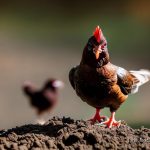Keeping chickens and bees together may seem like an unusual combination, but it can actually be a beneficial practice for both species. Chickens and bees have a symbiotic relationship that can enhance the productivity of your backyard farm or garden. By introducing chickens to your beekeeping setup, you can increase pollination, improve pest control, and create a more sustainable and diverse ecosystem. In this article, we will explore the benefits of keeping chickens and bees together, as well as provide tips on how to successfully integrate these two species.
Key Takeaways
- Keeping chickens and bees together can provide numerous benefits, including increased pollination, pest control, and egg production.
- Introducing chickens to your beekeeping setup requires careful planning and consideration of factors such as space, shelter, and safety.
- Chickens and bees have a symbiotic relationship, with chickens helping to control pests and bees providing valuable pollination services.
- Proper planning is essential for successfully keeping chickens and bees together, including choosing the right breeds of chickens and providing adequate shelter.
- When keeping chickens and bees together, it’s important to manage their health and safety, as well as to provide enough space and resources for both species to thrive.
The Benefits of Keeping Chickens and Bees Together
One of the main benefits of keeping chickens and bees together is increased pollination. Bees are known for their role in pollinating plants, which is crucial for the production of fruits, vegetables, and flowers. By having chickens in close proximity to your beehives, they can help attract bees to your garden or farm. Chickens produce carbon dioxide when they breathe, which is a natural attractant for bees. This can result in more efficient pollination and higher crop yields.
Another benefit of keeping chickens and bees together is improved pest control. Chickens are natural foragers and will eat insects, including pests that can damage your plants or harm your bees. They can help control populations of pests such as beetles, caterpillars, and grasshoppers. This reduces the need for chemical pesticides and promotes a healthier ecosystem.
How to Introduce Chickens to Your Beekeeping Setup
When introducing chickens to your beekeeping setup, it is important to do so gradually and provide separate areas for each species. Chickens can be curious creatures and may disturb the beehives if they have direct access to them. Start by introducing the chickens to a separate area near the beehives, such as a fenced-off section of your garden or a chicken run. This allows them to become familiar with the presence of the bees without causing any disruption.
Once the chickens are comfortable with the bees, you can gradually allow them access to the area around the beehives. However, it is important to provide a physical barrier, such as a wire fence, to prevent the chickens from getting too close to the hives. This will protect both the chickens and the bees from any potential harm.
Understanding the Relationship Between Chickens and Bees
Chickens and bees have a unique relationship that can benefit both species. Chickens can help protect bees from predators such as mice, rats, and birds. Their presence can deter these predators from approaching the beehives, reducing the risk of damage or loss of bees.
In return, bees can benefit chickens by providing them with a natural food source. Bees produce honey, which is a nutritious and energy-rich food that chickens enjoy. Chickens will eagerly consume any honey that may be spilled or leaked from the beehives. This can supplement their diet and provide them with additional nutrients.
The Importance of Proper Planning for Keeping Chickens and Bees Together
Proper planning is essential before keeping chickens and bees together. It is important to ensure that you have adequate space and resources to accommodate both species. Chickens require a coop or shelter to protect them from predators and provide them with a safe and comfortable environment. Bees require hives that are properly maintained and positioned to maximize their productivity.
Consider the size of your backyard or farm when planning for chickens and bees. Make sure there is enough space for both species to roam freely without overcrowding. Adequate space allows chickens to forage for insects and plants, while also providing enough room for bees to fly and gather nectar.
Choosing the Right Breeds of Chickens for Your Beekeeping Operation

When choosing breeds of chickens for your beekeeping operation, it is important to select ones that are docile and not prone to flying. Docile chickens are less likely to disturb the beehives or cause any harm to the bees. They are also easier to handle and manage.
Certain breeds of chickens, such as the Sussex or Orpington, are known for their calm and friendly temperament. These breeds are less likely to cause any disruptions to the beehives and can coexist peacefully with the bees.
Avoid selecting breeds of chickens that are known for their flightiness or aggressiveness, as they may pose a risk to the bees or cause unnecessary stress.
Providing Adequate Shelter for Your Chickens and Bees
Providing adequate shelter is crucial for both chickens and bees. Chickens require a coop that is secure, well-ventilated, and protected from predators. The coop should have nesting boxes for egg-laying, perches for roosting, and access to fresh water and food.
Bees require hives that are properly maintained and positioned. The hives should be placed in a location that receives adequate sunlight and is protected from strong winds. The hives should also be elevated off the ground to prevent moisture buildup and provide better ventilation.
It is important to ensure that the coop and hive are compatible and do not interfere with each other. The coop should be positioned in a way that does not obstruct the flight path of the bees or cause any disturbances to the hives.
Managing the Health and Safety of Your Chickens and Bees
Managing the health and safety of both chickens and bees is essential for their well-being. Regularly monitor your chickens for signs of illness or disease, such as changes in behavior, loss of appetite, or abnormal droppings. Provide them with a balanced diet, clean water, and regular veterinary care.
For bees, regularly inspect the hives for signs of disease or infestation. Look for any unusual behavior or changes in population size. Keep the hives clean and free from debris, and ensure that they have access to a variety of flowering plants for nectar and pollen.
Protect both chickens and bees from predators by implementing appropriate measures, such as installing fences or using predator deterrents. This will help ensure their safety and minimize the risk of harm.
How Chickens and Bees Can Help Each Other Thrive
Chickens and bees can help each other thrive in various ways. Chickens provide fertilizer for plants that bees pollinate. Their droppings are rich in nitrogen, phosphorus, and potassium, which are essential nutrients for plant growth. When chickens forage in the garden or farm, they naturally fertilize the soil with their droppings, promoting healthier and more productive plants.
Bees, on the other hand, enhance the productivity of the garden or farm by pollinating plants. Pollination is necessary for the production of fruits, vegetables, and flowers. Bees transfer pollen from the male parts of a flower to the female parts, allowing fertilization to occur. This results in the formation of seeds or fruits.
By keeping chickens and bees together, you can create a more sustainable and diverse ecosystem that benefits both species and promotes overall environmental health.
Tips for Managing the Space and Resources Needed for Keeping Chickens and Bees Together
Managing the space and resources needed for keeping chickens and bees together requires careful planning and organization. One tip is to rotate grazing areas for chickens to prevent overgrazing and allow vegetation to recover. This ensures that there is always enough food available for the chickens without depleting the resources.
Consider planting a variety of flowering plants that provide nectar and pollen for bees throughout the year. This will ensure a continuous food source for them and promote their health and productivity.
Provide separate feeding areas for chickens and bees to prevent competition for food. Chickens require a balanced diet that includes grains, vegetables, and protein sources, while bees rely on nectar and pollen for their nutrition.
The Challenges and Rewards of Keeping Chickens and Bees Together
Keeping chickens and bees together can come with its challenges, but the rewards are well worth it. One challenge is ensuring the safety of both species from predators. Predators such as raccoons, foxes, or bears may be attracted to the presence of chickens or beehives. Implementing appropriate measures, such as secure fencing or predator deterrents, can help mitigate this risk.
Another challenge is managing the space and resources needed for both chickens and bees. It is important to ensure that there is enough space for both species to thrive without overcrowding. Adequate resources, such as food, water, and shelter, should be provided to meet the needs of both chickens and bees.
The rewards of keeping chickens and bees together are numerous. You can enjoy the satisfaction of producing your own honey and eggs, knowing that they come from a sustainable and environmentally-friendly source. You can also create a diverse and thriving ecosystem in your backyard or farm, promoting biodiversity and supporting local pollinators.
Keeping chickens and bees together can be a beneficial practice for both species. By introducing chickens to your beekeeping setup, you can increase pollination, improve pest control, and create a more sustainable and diverse ecosystem. Proper planning, choosing the right breeds of chickens, providing adequate shelter, managing health and safety, and understanding the relationship between chickens and bees are all important considerations when keeping these two species together.
Consider incorporating chickens into your beekeeping operation to enhance the productivity of your backyard farm or garden. The benefits are numerous, and the rewards are well worth the effort. By keeping chickens and bees together, you can create a harmonious and thriving environment that benefits both species and promotes overall environmental health.
If you’re interested in keeping chickens and bees together, you might also want to check out this informative article on how many eggs geese lay. Geese are another type of poultry that can be a great addition to your backyard farm. Understanding their egg-laying habits can help you plan and manage your flock effectively. To learn more about geese and their egg production, click here: https://poultrywizard.com/breeding-geese/how-many-eggs-do-geese-lay/.
FAQs
What are the benefits of keeping chickens and bees together?
Keeping chickens and bees together can have several benefits. Chickens can help control pests and weeds in the garden, while bees can pollinate plants and increase crop yields. Additionally, chickens can help keep the area around the hive clean by eating any dead bees.
Is it safe to keep chickens and bees together?
Yes, it is safe to keep chickens and bees together as long as certain precautions are taken. The hive should be placed in an area that is not easily accessible to the chickens, and the chickens should be trained to stay away from the hive. Additionally, the hive should be securely fenced to prevent predators from getting in.
What should be considered before keeping chickens and bees together?
Before keeping chickens and bees together, it is important to consider the space available, the local regulations, and the temperament of the chickens and bees. Chickens and bees require different types of care and attention, so it is important to ensure that both animals can be properly cared for in the same space.
What are the potential drawbacks of keeping chickens and bees together?
One potential drawback of keeping chickens and bees together is that the chickens may disturb the bees and cause them to become agitated. This can lead to stinging incidents and may cause the bees to abandon the hive. Additionally, chickens may eat the honey or damage the hive, which can be detrimental to the bees.
What should be done to ensure the health and safety of both chickens and bees?
To ensure the health and safety of both chickens and bees, it is important to provide them with adequate food, water, and shelter. The hive should be regularly inspected for signs of disease or infestation, and the chickens should be monitored for any signs of illness or injury. Additionally, the area around the hive should be kept clean and free of debris to prevent the spread of disease.
Meet Walter, the feathered-friend fanatic of Florida! Nestled in the sunshine state, Walter struts through life with his feathered companions, clucking his way to happiness. With a coop that’s fancier than a five-star hotel, he’s the Don Juan of the chicken world. When he’s not teaching his hens to do the cha-cha, you’ll find him in a heated debate with his prized rooster, Sir Clucks-a-Lot. Walter’s poultry passion is no yolk; he’s the sunny-side-up guy you never knew you needed in your flock of friends!







